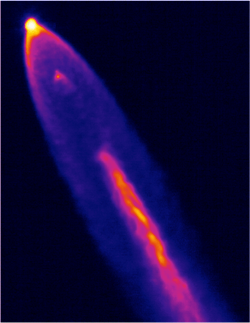NASA takes thermal-imaging video of SpaceX in powered descent, info to help with future Mars landings
NASA captured thermal images of a SpaceX Falcon 9 rocket on its descent after it launched in September, 2014 from Cape Canaveral Air Force Station in Florida. The data from these thermal images may provide critical engineering information for future missions to the surface of Mars, according to NASA.
NASA equipped two aircraft with thermal imagers to document re-entry of the rocket's first stage. The SpaceX Falcon 9's experimental first stage has a unique feature: rather than being discarded after use and falling to Earth, the prototype first stage uses its rockets to power itself down to the ground, allowing future reuse of the stage.
NASA captured high-definition thermal images and monitored changes in the first stage's smoke plume as the engines were turned on and off. The images were captured as the rocket began its descent at very high altitude where the Earth's atmosphere is as thin as Mars' atmosphere at altitudes down to ground level.
"Because the technologies required to land large payloads on Mars are significantly different than those used here on Earth, investment in these technologies is critical," says Robert Braun, principal investigator for NASA's Propulsive Descent Technologies (PDT) project and professor at the Georgia Institute of Technology in Atlanta. "This is the first high-fidelity data set of a rocket system firing into its direction of travel while traveling at supersonic speeds in Mars-relevant conditions."
NASA's Scientifically Calibrated In-Flight Imagery (SCIFLI) project team at NASA's Langley Research Center in Hampton, Virginia, had their eyes, cameras and telescopes trained on the Falcon with the help of two long-range aircraft provided by NASA and the U.S. Navy.
Nose-mounted gimbaled IR system
A NASA WB-57, a twin jet engine high-altitude research aircraft from Johnson, was equipped with a long-range infrared optical system to capture the images. It is a unique full-motion video camera system that is gimbal-mounted on the nose of the WB-57. It collects full-color high definition and infrared video.
A Navy NP-3D Orion aircraft from the Naval Air Systems Command Weapons Division's Air Test and Evaluation Squadron-30 at Point Mugu, California, was equipped with a long-range infrared optical system and also took thermal images of the launch.
On launch day, the WB-57 and NP-3D Orion reached their observation locations about 50 miles from the projected rocket trajectory. After launch, the rocket emitted enough thermal energy for the plane's infrared cameras to catch a glimpse. Both flight crews then worked to obtain data as the first stage descended at supersonic speeds off the coast of Georgia.
About the Author
John Wallace
Senior Technical Editor (1998-2022)
John Wallace was with Laser Focus World for nearly 25 years, retiring in late June 2022. He obtained a bachelor's degree in mechanical engineering and physics at Rutgers University and a master's in optical engineering at the University of Rochester. Before becoming an editor, John worked as an engineer at RCA, Exxon, Eastman Kodak, and GCA Corporation.

